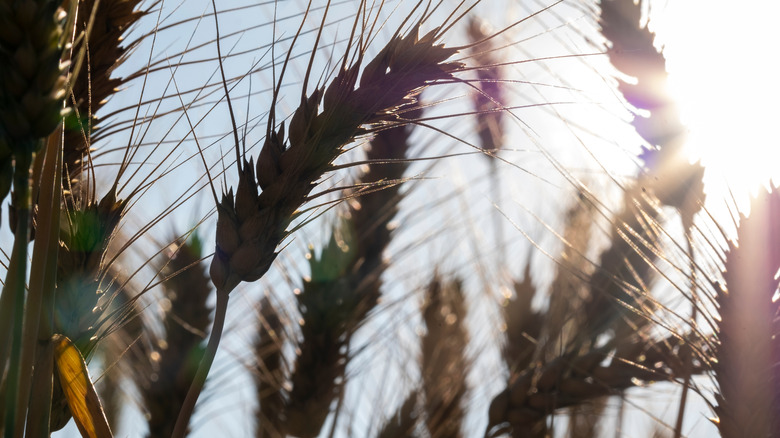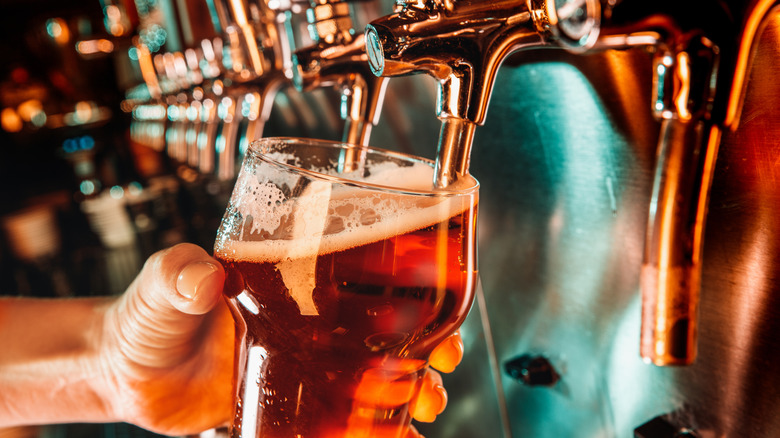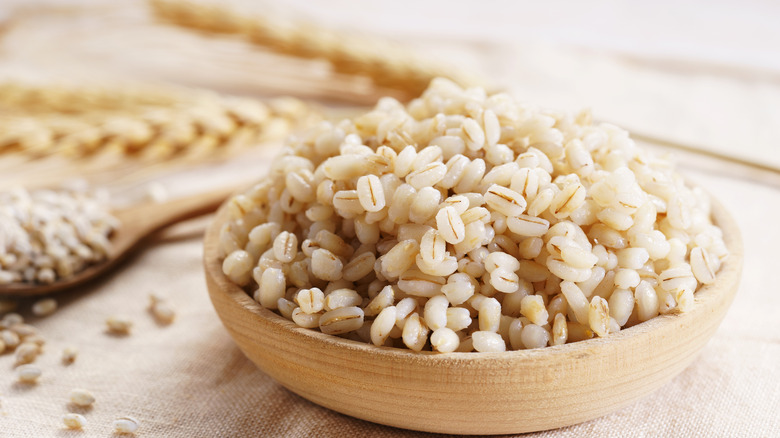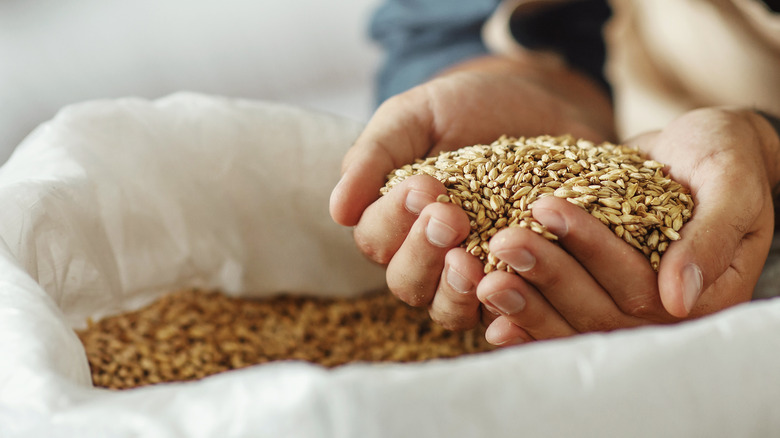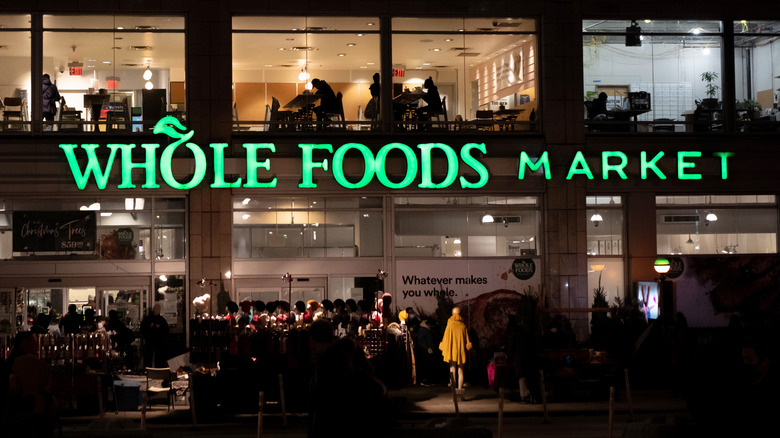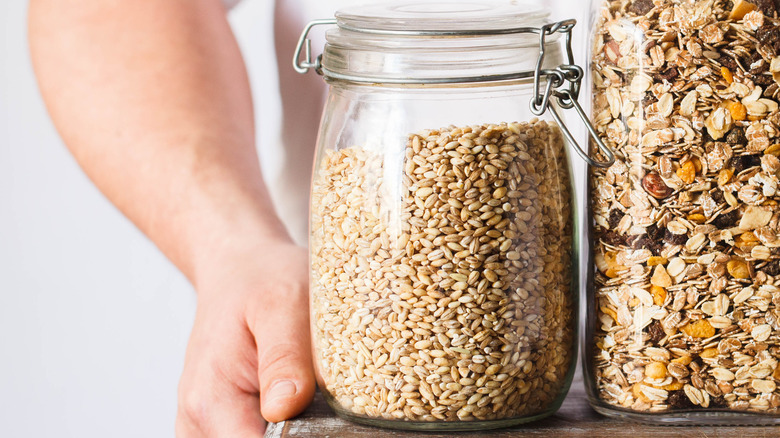What Is Barley And Is It Gluten-Free?
We may receive a commission on purchases made from links.
Barley (scientific name Hordeum vulgare) is, according to Britannica, a "cereal plant of the grass family Poaceae and its edible grain." But barley isn't just any old grain. It's "the fourth largest grain crop globally," with only wheat, rice, and corn ahead of it. Barley is known as an ancient grain, and for good reason: its cultivation dates all the way back to 5000 BCE. Despite its long history and massive global presence, barley tends to be under-appreciated in the United States. This is hardly surprising, considering that America is only 10th on the list of barley-producing countries, according to World Mapper — Russia, Germany, France, Ukraine, and Australia are all much more acquainted with the grain.
It's a grain you should get to know, though. It's nutritious and can be delicious, but it's not the best choice for everyone. Now, to answer the burning question: is barley gluten-free?
The answer is no, barley is not gluten-free, though Healthline notes it has a relatively low gluten content. If you avoid gluten primarily as a matter of choice, not medical necessity, then you should be fine to eat barley. But if you have celiac, sadly barley belongs off the menu.
What is barley used for?
In centuries (and millennia) past, barley was a staple crop for many civilizations, both for human consumption and for feeding livestock. Today, despite its great taste, high protein content, and many health benefits, Britannica explains that barley is primarily grown for two reasons: as an animal feed, and for use in the brewing of alcoholic beverages, primarily beer and whiskey. Distiller.com notes that in the latter context, it is sometimes called malted grain.
That said, barley is also a common ingredient in many foods. In its most basic cooked state (boiled in water, like rice or pasta) barley is often used in soups and stews or in salads and wraps. It's also served as-is, much like rice, couscous, or another staple starch. Barley can also be used to make breads and other baked goods when it has been processed into barley flour (via Bob's Red Mill).
Because barley is a hearty crop that grows well in various climates, it is featured in a diverse array of regional cuisines, from North Africa to the Himalaya to America to Europe and beyond, per Britannica.
Cooking with barley
There are many ways to cook with barley. As noted, it can be ground into a flour and used to make baked goods. It can be used in the production of beverages like beer; it can be eaten as a paste. But arguably the best way to consume the barley you will find at most grocery stores is to cook it on a stovetop.
To cook pearl barley (the type you are likely to find — check the packaging to be sure), first rinse it well under cool running water. Then, in a sauce pan, combine one cup of barley with three cups of water or broth and then bring the liquid to a boil. Reduce the heat to a simmer and then cover the pan with a lid. Simmer the barley for about 25 minutes (it may take a few minutes longer) and then check it for doneness. Properly cooked barley will be "tender yet chewy," according to MasterClass.
If the barley is drying out during the cooking, add a bit more water; once it is done cooking, drain the excess water and fluff up the grains with a spoon or fork before serving, just like you would with rice.
The health benefits of barley
In our ever more health-conscious world, barley deserves a major comeback, because it is a majorly healthy grain. Healthline explains that barley contains a notable amount of "vitamins, minerals, and other beneficial plant compounds," and can be a "particularly rich source of fiber, molybdenum, manganese, and selenium" when it is eaten in its hulled or whole grain form.
A few of the specific nutrients you will get from a serving of barley are vitamin B6, iron, zinc, and magnesium. You can get a decent 12.5 grams of protein per an approximate 350 calorie serving of barley, with only 2.3 grams of fat. Barley is good for digestive health and helps manage blood sugar levels. Some people it may help with weight management and with maintaining healthy levels of cholesterol.
But again, barley is not gluten-free so if you have a recognized gluten intolerance or diagnosed celiac disease, you should not eat barley.
Where to buy barley
These days, you can find barley at just about any grocery store of decent size. Despite being less popular than wheat, rice, or corn, barley is nonetheless relatively common. Look for it in the same aisles where you find rice or pastas, or in specialty food sections geared around health foods. And if you cannot find barley on the shelves at a store near you, you can easily order it online.
Regardless of where you are getting your barley, you will need to pick the type you want. In most cases, that comes down to hulled barley versus pearl barley. Pearl barley is not technically a whole grain, and while it can be easier to cook and more tender as the husk and bran layer have been removed and the grain polished, it is not as nutritious, according to The Washington Post. Hulled barley has the indigestible outer husk removed but is otherwise intact — it is a whole grain.
How long does barley last?
Barley is a very shelf stable grain, making it a good dry grain to keep on hand in your pantry. According to Unlock Food, "Uncooked barley should be stored in an airtight container. It will keep in a cool, dry place such as a pantry for up to one year." This can be the original packaging in which you bought the barley or in a sealed container, such as a jar or plastic vessel.
Once cooked, barley becomes less stable, of course, as far as spoilage goes. Cooked barley should also be kept in an airtight container and will keep safely in the fridge for four or five days. It can also be stored in the freezer for about one month, whether it is frozen on its own or as part of a soup, stew, or other dish you are saving for later. Though it's not as common in America, its versatility and health benefits make barley a grain worth trying.
